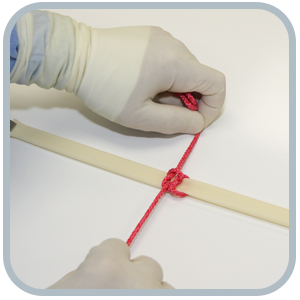Introduction and Learning Objectives
Ver
Learning to tie surgical knots requires proper handling of the suture strands, as well as proper positioning of your body. In this lesson, you will start by learning the terminology for the finger, hand, and wrist motions used to teach the knot-tying techniques in this module. Next, you will learn the basic maneuver for uncoupling your fingers. Finally, you will learn about the importance of adopting a consistent set-up and surgeon’s perspective when tying knots within any surgical field.

Learning Objectives
By the end of this lesson, you will be able to:
- Know common terms related to hand and wrist movements and positioning so that you will be able to follow detailed instructions for knot tying later in this module.
- Know why you must practice uncoupling your thumb and index finger from your middle, ring, and little fingers during hand tying.
- Know why it is so important that the surgeon "set up" for suture knotting correctly and consistently, and why maintaining the same perspective when tying structures with varying orientations helps reduce improper knot formation and operator confusion.
Última modificación: jueves, 3 de diciembre de 2015, 15:39
